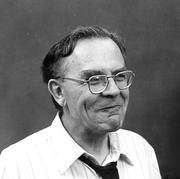Geoffrey Wilkinson
Sir Geoffrey Wilkinson | |
|---|---|
 Wilkinson, c. 1976 | |
| Born | 14 July 1921 Todmorden, West Riding of Yorkshire, England |
| Died | 26 September 1996 (aged 75) London, England |
| Nationality | British |
| Alma mater | Imperial College London (PhD) |
| Known for | Homogeneous transition metal catalysis |
| Awards |
|
| Scientific career | |
| Fields | Inorganic chemistry |
| Institutions | |
| Thesis | Some physico-chemical observations on hydrolysis in the homogeneous vapour phase (1946) |
| Doctoral advisor | Henry Vincent Aird Briscoe[2] |
| Other academic advisors | Glenn T. Seaborg (post doctoral advisor) |
| Doctoral students | |
| Other notable students | Richard A. Andersen (postdoc) |
Sir Geoffrey Wilkinson
Education and early life
Wilkinson was born at Springside, Todmorden, in the West Riding of Yorkshire. His father, Henry Wilkinson, was a master house painter and decorator; his mother, Ruth, worked in a local cotton mill. One of his uncles, an organist and choirmaster, had married into a family that owned a small chemical company making Epsom and Glauber's salts for the pharmaceutical industry; this is where he first developed an interest in chemistry.
He was educated at the local council primary school and, after winning a County Scholarship in 1932, went to
Career and research
In 1942 Professor
He was at Harvard University from September 1951 until he returned to England in December 1955, with a sabbatical break of nine months in Copenhagen. At Harvard, he still did some nuclear work on excitation functions for protons in cobalt, but had already begun to work on olefin complexes.
In June 1955 he was appointed to the chair of Inorganic Chemistry at Imperial College London, and from then on worked almost entirely on the complexes of transition metals.

Wilkinson is well known for his popularisation of the use of
He supervised PhD students and postdoctoral researchers including John A. Osborn, Alan Davison[3][4] and Malcolm Green.[5]
Awards and honours
Wilkinson received many awards, including the
He was elected a
Personal life
Wilkinson was married to Lise Schou, a Danish plant physiologist whom he had met at Berkeley. They had two daughters, Anne and Pernille.[1]
References
- ^ .
- ^ a b c "Geoffrey Wilkinson – Autobiography". nobelprize.org. 11 October 2012. Archived from the original on 11 October 2012. Retrieved 20 July 2021.
- ^ hdl:10044/1/13205.
- ^ ISSN 0080-4606.
- ^ a b Green, Malcolm Leslie Hodder Green (1958). A study of some transitional metal hydrides and olefin complexes. london.ac.uk (PhD thesis). Imperial College London.
- .
- ^ "Geoffrey Wilkinson Patents". Archived from the original on 7 November 2017. Retrieved 31 October 2006.
- EThOS uk.bl.ethos.587112
- ^ Mainz, Vera V.; Girolami, Gregory S. (1988). "GENEALOGY DATABASE ENTRY – Wikinson, Geoffrey" (PDF). scs.illinois.edu.
- ^ "Sir Geoffrey Wilkinson | British chemist". 10 July 2023.
- ISSN 0869-7876.
- .
- ISBN 9780471199571.
- ^ Wilkinson Hall at Imperial College London
External links
- Geoffrey Wilkinson on Nobelprize.org

